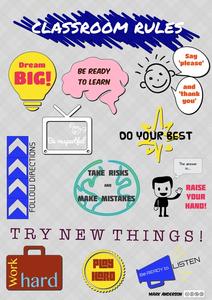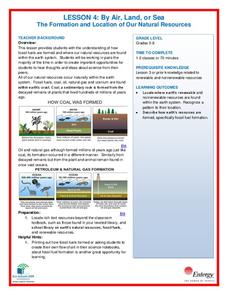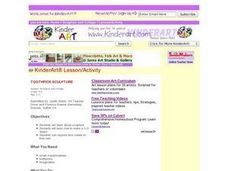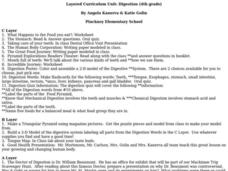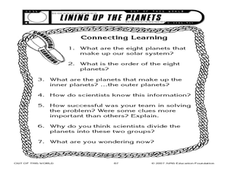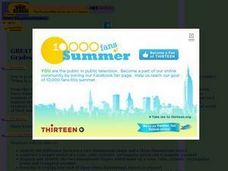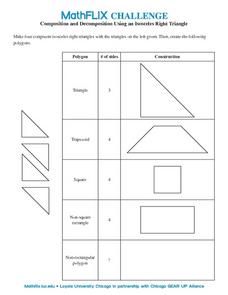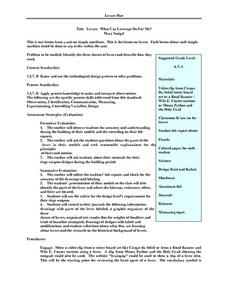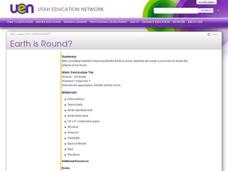Curated OER
Classroom Rules
Rather than focus on punitive actions and consequences for mistakes, make a safe and inspiring learning environment the rule of your classroom.
National Wildlife Federation
By Air, Land, or Sea: The Formation and Location of Our Natural Resources
Coal forms from the ancient remains of plants that were alive on Earth before the dinosaurs! Scholars use their t-charts from the previous lesson over resources and research to determine if their information is correct. Through analysis...
Science Geek
Stoichiometry
Watch your class react when you tell them they're going to study stoichiometry! The lesson demonstrates four examples. Scholars must write and balance the chemical equation and then make the conversion to find the correct mass or volume....
University of Adeaide
Basic Trigonometry and Radians
A fabulous set of examples and problems that introduce basic trigonometry concepts, this packet is set apart by the care it takes to integrate both radians and degrees into the material. After defining radians, the author demonstrates...
EngageNY
General Pyramids and Cones and Their Cross-Sections
Are pyramids and cones similar in definition to prisms and cylinders? By examining the definitions, pupils determine that pyramids and cones are subsets of general cones. Working in groups, they continue to investigate the relationships...
Curated OER
The Creaky Door Says "ehhhh"
Study the long vowel sound /e/, as in a creaky door noise. Children repeat the sound and learn a chant. They use letters in letterboxes to make words with the /e/ sound before reading a book and writing a message about their favorite...
Curated OER
Toothpick Sculpture
You'll be surprized at how much engineering, design, and creativity can go into a toothpick and a marshmallow. Learners make toothpick sculptures where they construct three-dimentional models by sticking marshmallows and toothpicks...
Curated OER
Digestion
Fourth graders answer the question what happens to the food you eat? They complete a worksheet about the food you eat. They discuss the different types of teeth that we have. Students complete digestion poster in which they color and...
Curated OER
Exploring The Depths!
Fifth graders make a model of the ocean floor. In this ocean characteristics lesson plan, 5th graders complete a KWL chart about the ocean floor, use the Ocean Depth Data Sheet to create a graph, and create a 3-D model of the ocean...
Curated OER
Lining up the planets
Pupils follow cue cards in order to order the planets in the correct order in the solar system. In this planets lesson plan, students work in groups to make a 2D model of the planets.
Curated OER
Muscle Cars
In this technology worksheet, middle schoolers find the words related to the types of cars and models in the word search. The answers are found by clicking the buttons at the bottom of the page.
Curated OER
Great Shapes Alive!
Compare two- and three-dimensional shapes and construct three dimensional models from two-dimensional shapes. Diagram the shapes and reflect about the process in writing.
Curated OER
Pop-it...Stop-it
Students observe how certain geometric shapes can be used to make some structures rigid and others flexible. The activity involves construction of a 30-60 right triangle, folding while following directions, and identifying polygons.
Curated OER
Isosceles Right Triangle
In this isosceles right triangle worksheet, 10th graders solve and complete 5 different constructions of composition and decomposition. First, they make 4 congruent isosceles triangles with the model on the left. Then, students create...
Curated OER
Captivating Characters
Students read a book on their own and identify the characteristics of fantasy literature. After finding quotes from their favorite characters, they use construction paper to make models of them. To end the lesson, they use watercolors to...
Howard Hughes Medical Institute
Modeling Food Webs in Darién, Panama
It's a jungle out there! Young biologists journey to Darien, Panama to examine the intricate relationships between the organisms that inhabit the jungle. Groups begin by demonstrating an understanding of energy flow in ecosystems, then...
NASA
Development of a Model: Analyzing Elemental Abundance
How do scientists identify which elements originate from meteorites? Scholars learn about a sample of material found in a remote location, analyzing the sample to determine if it might be from Earth or not. They study elements, isotopes,...
EngageNY
Truncated Cones
Learners examine objects and find their volumes using geometric formulas in the 21st installment of this 25-part module. Objects take the shape of truncated cones and pyramids, and individuals apply concepts of similar triangles to find...
Curated OER
Cells are 3-D!
Students design three dimensional models of plant and animal cells. They identify the cells parts, and compare animal and plant cells.
Curated OER
Vocabulary Multiple Choice Worksheet 12
In this advanced ESL vocabulary worksheet, students read 10 sentences that contain missing words. Students analyze the 4 similar word choices given and select the word that will correctly complete the sentence.
Curated OER
Problem Solving
Students identify problem solving strategies and demonstrate the ability to make choices using those strategies. For this problem solving lesson plan, students are introduced to vocabulary and strategies by playing a hula hoop game, then...
Curated OER
Castles and Fortresses of the World
Learners work in groups to study castlers and fortresses of the world. They study pictures and models of well known castles and fortresses. Students construct a 3-D model of a castle or fortress using materials of their choice.
Curated OER
Levers: What Can Leverage Do For Me?
Students determine the identity of the three classes of levers while explaining how each works. They wait a video clip that shows uses for different types of levers and work as a class to write a KWL chart. Finally, they make a model fo...
Curated OER
Earth is Round?
Third graders discuss how Aristotle concluded that the Earth was round. As a class, they review theories about the Earth's shape and describe how life on Earth would be different if it were flat. Individually, they make a moon book in...
